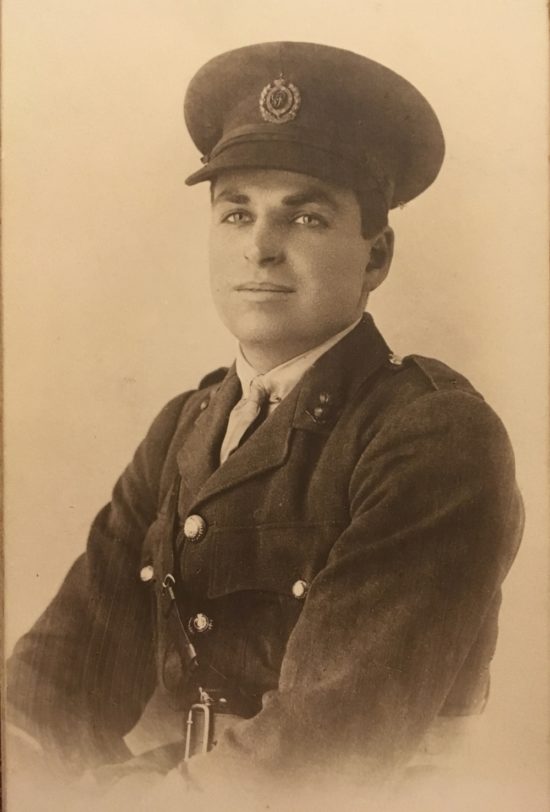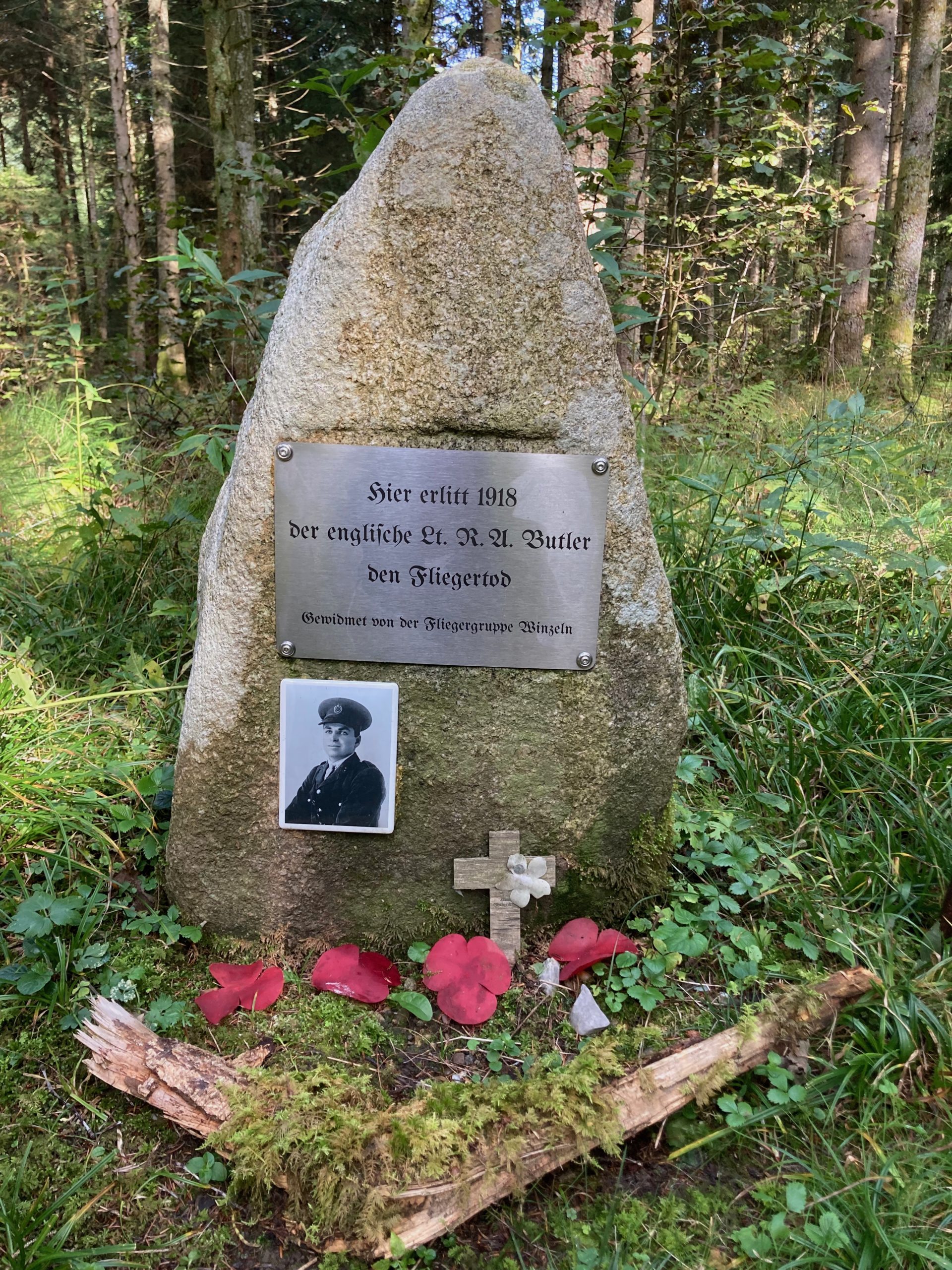Remembering Reginald Butler
Today, Sunday 11th November 2018, marks the centenary of the end of World War I, known then as The Great War. On this remembrance day, Egham Museum is remembering Egham resident and Royal Air Force Lieutenant, Reginald Arthur Butler.

Reginald Arthur Butler was born in Egham in 1894, the eldest son of Arthur Bayne Butler, who used to run a book and stationery shop in Egham High Street from 1913, and his wife Elizabeth Mary Tubbs. At the time, the family lived in Runnemede Road, Egham. Reginald had a brother, Cecil James, and two sisters Marjorie and Lona Muriel.
Reginald trained for two years as a cadet at the Incorporated Thames Nautical Training College, HMS Worcester, Greenhithe, then served as an apprentice at sea for 3 years, before obtaining a Second Officer’s certificate and serving on various HM ships. He was then transferred to the Royal Engineers and subsequently sent to France to join the Royal Air Force.
Reginald was 20 years old when the War started, and in France, was assigned to the 55 Royal Air Force bomber squadron.

During the First World War, an objective of the Air Force was the bombing of German Industrial centres and for this reason, the areas of Oberndorf and Neckarstadt were attacked many times. The last of those attacks happened on Saturday 20th July 1918, when two British bombers from Squadron 55 Independent Air Force were involved in a bombing raid. The two squadrons were formed of a total of 11 2-seater de Havilland aeroplanes and their targets were the Mauser weapons and munitions factories in Oberndorf. Reginald Butler was the gunner/observer in one of those de Hallivands and was sat behind Lieutenant Christopher Young who was piloting. The attack started at 8:15am and the squadrons dropped a total of 24 bombs, which fortunately didn’t cause any deaths or injuries to the civilian population. In fact, the only victims of this battle were soldiers from both fronts.
Until 8:27am the Germans responded to the attack with 445 heavy calibre shells fired by the Oberndorf Flak-group (anti-aircraft group), followed at 8.30am by an attack from German fighter planes and aerial combat began. Two English bombers and two German fighters were shot down. A total of five men, three English and two Germans, died in this combat.
According to the official reports, one de Hallivand came under defensive fire from the anti-aircraft guns. The English pilot Lt. Christopher Young was fatally shot in the head and died immediately. The aeroplane caught fire and started to fall. The second occupant of the plane, Lt. Reginald Butler, jumped out just before the impact, on to the treetops in Fluorn-Winzeln in the Black Forest, but as he didn’t have parachute, he fell to the ground and died.
The other English de Hallivand which came under attack was occupied by observer Sergeant Baker who died under fire, and the pilot, Sergeant Nash, who survived. On the other side, the Germans suffered the loss of two men, Warrant Officer Paul Felsmann and Warrant Officer Johann Dierle, although their deaths were not reported, or even mentioned, in the local press due to the German war censorship.
Butler’s body was not immediately found by the initial searches, however on the 1st August 1918, a few days later, a local brush-wood collector named Franz Schmidt found it 800 metres from the site of the plane’s crash. The body of Lieutenant Butler was taken to the Oberndorf cemetery on 2nd August 1918 and buried. Subsequently in 1922 and 1927, the British government ordered that the British and Commonwealth war dead, who had fallen in Germany, be collected together in four key war-grave cemeteries. Reginald Arthur Butler’s final resting place is the Niederzwehren Military Cemetery, near Kassel.
In the forest however, at the place where Butler’s body was found, local residents erected a wooden cross as a mark of respect for the British airman. The wooden cross was changed every 5 to 6 years, and always looked after by the residents who used to bring flowers and pay respect to the so called Englishman’s Cross. Later, in the 1950’s, the “Robert Moser” glider pilot group of the German Air Sports Association replaced the wooden cross with a durable granite stone with a commemorative plaque written in Gothic style. The maintenance and care of this small monument to Egham resident is still possible thanks to local volunteers who look after it.

R.A Butler is commemorated on the Egham War Memorial in St John’s Church, Egham and is also listed on Egham Museum’s HistoryPin collection.
This story hasn’t been forgotten thanks German researchers such as Emil Moosmann and Dieter Mönch, with the help of Alfred Danner from the Oberndorf City Archive. The articles produced by their research arrived with us at Egham Museum thanks to Egham resident Barrie Reynolds, who offered support when, in 2012, Dieter Mönch contacted the Egham United Church to look for help among the Egham community to find any living relatives of the Butler family. At that time no relatives had been found, but after much research, a great-niece of Reginald Bulter has been located and she is very pleased and welcomes the sharing of her family’s memories about her great-uncle. With the permission of the family, Barrie Reynolds has added Butler’s story on the Imperial War Museum’s ‘Lives of the First World War’ archive which contains further information and reference sources.
On the centenary of the end of the First World War, Barrie Reynolds comments: “The remarkable thing in all of this is the common humanity of people who, starting in one war and continuing through another, continued to respect and maintain the memorial at the place where an enemy and total stranger had died”.
We thank Barrie for sharing this story, and you can read about his involvement in his own words below:
“The story of my eventual involvement with the memorial in the Black Forest started in 2012, when a volunteer local history researcher, Emil Moosmann, who was interested in documenting the many small memorials etc. in the Fluorn-Winzeln area of Germany, published a short report in his local newspaper about the existence of a memorial stone for a British airman – Lt. Reginald Arthur Butler – who died on 20th July 1918 in the Winzeln Forest.
That report made Dieter Mönch, who lives in Fluorn-Winzeln, curious, and having seen a display of items in the Oberndorf Museum related to the incident, he began his own research into the background to the memorial, and the events of that day in 1918. After six months of checking available records, and interviewing local people, he managed to piece together the events of the fateful day which involved the deaths of three British airmen, and two German pilots, and he produced a detailed research report.
Those events are the subject of “Das Engländerkreuz im Winzelner Wald” (The Englishman’s Cross In The Winzeln Forest), by Dieter Mönch.
At that time, he then wrote and sent a copy of his report to the Egham community in 2013 via the United Church of Egham, which is adjacent to Runnemede Road.,seeking support in finding any living relatives of Lt. Butler, whose parents were listed as living in that road at the time of Lt. Butler’s death. As the report was in German, I offered to help, and because my curiosity was aroused as I live only a few doors away from the 1918 home of Lieutenant R.A.Butler’ parents. Although some more information was found, I was unable to trace any living relatives at the time.
Dieter Mönch, meanwhile, had taken over care of the monument, and in July 2018, very appropriately on the day of the centenary of Lt. Butler’s death, had another article published in his local newspaper, and sent me a copy to keep me informed.
With the impending 100-year anniversary of the end of the First World War approaching, I had already decided to undertake a full translation of Dieter’s original report, and I have made that and the German newspaper articles available to the Egham Museum, in English. His recent newspaper article spurred me to check again, via a friend with extensive family history expertise, whether any more recent information had come to light. From that we learned that we could at last confirm from census records that there were, indeed, unidentified living relatives, and moreover that a great-niece had recently placed a related family tree on one of the family history sites. Via the messaging service offered from that website I then have established contact with the relatives, with Dieter’s permission have shared all the information, and have received back – as the final piece of the jig-saw – a very striking photo of “Reggie” Butler in uniform, for which Dieter was very grateful.”

